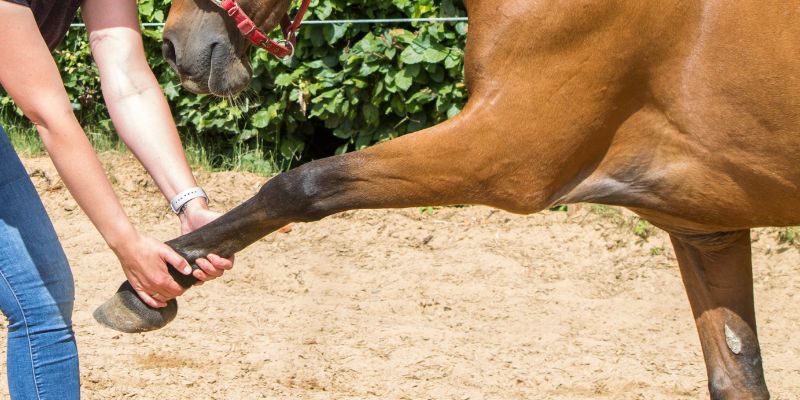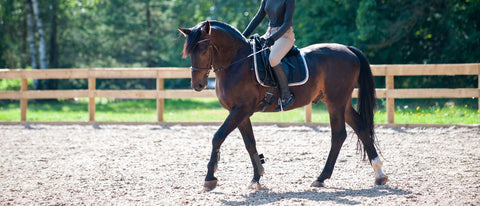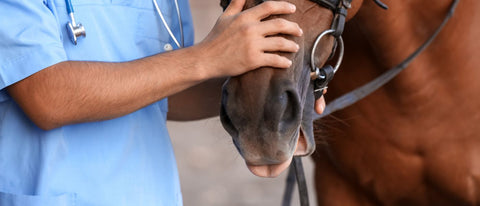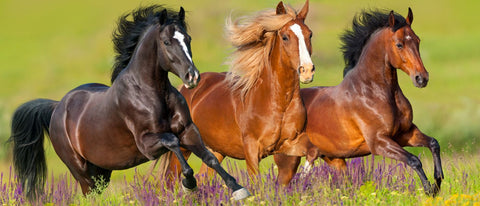
Florian ist aufgewachsen auf einem Bauernhof. Umgeben von Pferden, entdeckte er früh seine Faszination für diese majestätischen Tiere. Inspiriert von seiner reitbegeisterten Mutter, entwickelte er das Nahrungsergänzungmittel - Pferdegold. Seine tiefe Verbundenheit zur Natur und die leidenschaftliche Hingabe zu Pferden trieben ihn an, sein Unternehmen zu gründen.
What could be more beautiful than a horse galloping happily across the pasture? Unfortunately, even our four-legged friends are not immune to health problems.
This can lead to unexpected situations in which your horse suddenly becomes lame, dampening its joy of life. A lame horse is a challenge for every horse owner.
But what exactly does lameness mean in horses and how can you properly treat your faithful companion?
From slight irregularities in gait to significant pain reactions – the spectrum of lameness in horses is wide.
In this guide you will find comprehensive information on the causes of lameness and available treatment options.
We'll show you how to recognize a lame horse, what the reason might be, and what steps you should take.

Horse lame: Everything you need to know at a glance
Lameness in horses can have many faces. It's important to recognize the early signs and interpret them correctly.
In this section, you will learn how to detect lameness in your horse .
From careful observation of gait to professional diagnosis by a veterinarian – we cover all important aspects.
This way you are well informed and can support your horse effectively.
How can the severity of lameness be differentiated?
Lameness in horses can vary greatly in intensity.
It is crucial to understand the different levels of severity in order to respond appropriately.
The correct assessment helps to initiate the appropriate treatment.
How to distinguish between supporting leg lameness and hanging leg lameness
Support leg lameness in horses, especially when the horse is lame in the front, is often characterized by a shortened stance phase of the affected leg.
The horse tries to quickly shift its weight to the other leg to avoid pain.
In hanging leg lameness, however, the swing phase of the leg is affected. The horse lifts the leg unusually high or swings it noticeably outward.
Both forms of lameness can indicate different causes, such as joint problems or injuries. Careful observation and diagnosis by an expert are essential.

Perfect for your horse: Pferdegold® supplementary feed!
These specially developed supplements support your horse's diet and provide it with natural nutrients. Made in Germany, grain-free and drug-free, with a 30-day money-back guarantee.
Try it now!What is meant by mixed lameness in horses?
Mixed lameness in horses is a combination of supporting leg and hanging leg lameness . Symptoms of both types of lameness are evident in different phases of movement.
This can make recognition and diagnosis difficult, as symptoms vary and cannot always be clearly assigned to one category.
Mixed lameness requires a particularly careful examination to identify the underlying causes and treat them effectively
Lameness in horses: symptoms and first signs
Lameness in horses manifests itself in various forms. A clear sign is when the horse limps in the hindquarters without any visible swelling.
This often indicates problems in the hindquarters , such as hip or joint problems . If the horse is lame in the front, it may be due to problems in the shoulder or forelegs .
Shoulder lameness in horses is often recognized by uneven movements or a noticeable protective posture.
Early detection of lameness is crucial. Observe changes in gait , especially in the trot. Sometimes lameness is only evident in certain gaits, for example, if the horse is lame only in the trot.
Such specific signs can indicate the onset of problems. Careful observation of your horse's gait and behavior is important to ensure prompt and appropriate response.

All causes at a glance
Lameness in horses can have many causes. Here's an overview of the most common ones:
-
Muscle injuries: Often caused by overexertion or accidents, they manifest themselves as pain and limited mobility.
-
Tendon and ligament injuries: Often caused by sudden movements or overuse, they lead to swelling and lameness.
-
Joint inflammation and joint problems: Can be caused by wear and tear, injury or infection and are manifested by swelling, warmth and restricted movement.
-
Hoof problems: From hoof ulcers to malocclusions, hoof problems are a common cause of lameness.
-
Spine and neck problems: Injuries, wear and tear, or misalignments of the spine and neck can lead to pain and restricted movement.
-
Blunt trauma: Caused by impacts or blows, can lead to internal injuries and pain.
- Bacterial and viral infections: Can lead to inflammation in various areas of the body, causing lameness.
Here is a more detailed overview of the most common causes of lameness:
Muscle injuries in horses
Muscle injuries in horses often result from overexertion or accidents . Typical symptoms include pain, swelling, and limited mobility.
Early treatment and sufficient rest periods are crucial for healing.
Tendon and ligament injuries in horses
Tendon and ligament injuries are often the result of excessive strain or sudden movements. They lead to swelling, pain, and lameness.
A quick diagnosis and appropriate treatment are important to prevent long-term damage.
Joint inflammation and joint problems in horses
Joint problems, such as arthritis or inflammation, arise from wear and tear , overuse , or injury. Symptoms include swelling, pain, and limited mobility.
Early diagnosis and treatment are important to avoid long-term damage.
Spinal and neck problems in horses
Problems in the neck and back area, such as tension or spinal injuries, can also cause lameness. Symptoms often include altered posture or difficulty with certain movements.
Blunt trauma in horses
Blunt trauma caused by bumps or blows can lead to internal injuries . Watch for swelling, tenderness, or behavioral changes that could indicate pain.
Bacterial and viral infections in horses
Infections can lead to inflammation in various parts of the body, causing lameness. Watch for common symptoms of illness such as fever , loss of appetite , or lethargy , and consult a veterinarian immediately if you suspect any of these symptoms.
Horse is lame: What you can do
If your horse is lame, quick and careful action is required. First, you should carefully examine the affected area and check for swelling, warmth , or injuries .
Avoid putting further strain on the horse and keep it calm.
Early examination by a veterinarian is essential to diagnose the cause of lameness and initiate appropriate treatment.
During the recovery period, it is important to follow the veterinarian's instructions carefully and care for the horse accordingly.

Nutritional tips for lame horses
An adapted diet can make a significant contribution to supporting lame horses.
Here are some important aspects :
✔ Balanced basic nutrition: A balanced diet is essential for your horse's health. It should contain all essential nutrients, vitamins, and minerals to strengthen the immune system and support the body's natural healing process.
Make sure the feed is high quality and meets your horse's specific needs, especially if it is recovering from an injury or illness.
✔ Omega-3 fatty acids: Omega-3 fatty acids are known for their anti-inflammatory properties.
They can help reduce inflammatory reactions in the body, which is particularly beneficial for joint problems. Sources of omega-3 fatty acids include flaxseed or special feed supplements.
Regular intake of these fatty acids can help improve your horse's well-being.
✔ Natural nutrients: Glucosamine and chondroitin are two substances commonly used in horse feed supplements.
Glucosamine is a natural substance found in connective tissue, cartilage, and synovial fluid. Chondroitin , also a naturally occurring substance in the body, is bound to proteins in tissue and is a major component of cartilage (Greek: chondros), as well as bones and connective tissue.
✔ High-quality proteins: Proteins are essential for muscle recovery and maintenance. Make sure your horse receives high-quality, easily digestible protein sources.
This can be especially important if the horse is recovering from an injury or is older.
✔ Vitamin and mineral supplements: Vitamins and minerals play an important role in supporting overall health and the immune system.
Supplementation with vitamins such as vitamin E and minerals such as zinc and selenium can be helpful, especially if the horse is exposed to increased stress factors or is in a recovery phase.

Pferdegold® supplementary feed!
Pferdegold is a small family business from Bavaria with a big dream: to produce the best horse feed. We see ourselves as a family of equestrians who want to provide your horse with the ideal nutrition. 100% natural and perfectly tailored to your horse's needs.
Try it now!When should you take your horse to the vet?
If your horse walks unevenly, shows a changed posture or shows pain reactions such as twitching or backing away , it is advisable to consult a veterinarian.
Even if the horse is lame after visiting the farrier , you should take this seriously, as it could indicate a problem with the hoof trimming or a deeper cause.
If lameness persists or recurs, especially if accompanied by swelling or warmth in the affected areas, a veterinary examination is essential.
What to do in an emergency before the vet arrives?
In an emergency, it's important to stay calm and reassure your horse. Avoid unnecessary movement to prevent the injury from worsening.
Ensure a safe environment and remove potential hazards . If possible, apply a cooling compress to the affected area to reduce any swelling.
Contact a veterinarian immediately and describe the symptoms and observations in detail to ensure quick and effective help.
How lameness is treated by the veterinarian
The treatment of lameness in horses depends on the underlying cause.
The veterinarian will first perform a thorough examination to diagnose the cause of the lameness.
This typically involves observing the horse's gait to identify irregularities and pain points. Additionally, an examination of the hooves, joints, and muscles may be necessary, as well as imaging techniques such as X-rays or ultrasound .
Treatment can range from rest and anti-inflammatories to specific therapies such as shockwave therapy or surgery .
In some cases, an adjustment to your diet or exercise plan may also be necessary to best support a full recovery.
That is why regular visits to the farrier are so important
Regular visits to the farrier can contribute significantly to your horse's well-being. Professional hoof care helps prevent problems such as misalignments or hoof ulcers, which can lead to lameness.
If a horse is lame after visiting the farrier, this may indicate improper hoof trimming and should be checked immediately.
The farrier also plays an important role in preventing lameness by regularly checking the hooves and correctly shoeing or trimming them. This ensures optimal hoof health and supports the horse's overall mobility.

Preventing lameness: Helpful strategies for prevention
A key strategy for preventing lameness is regular and professional hoof care to avoid problems such as malocclusion or hoof ulcers. A balanced diet containing all the necessary nutrients is also crucial. Ensure adequate exercise and avoid overtraining to prevent muscle, tendon, and joint problems .
Regular veterinary examinations can detect and treat problems early. It's also important to keep the horse in a safe and appropriate environment to prevent accidents and injuries.
Conclusion
In conclusion, lameness in horses is a very complex issue that requires attention and care.
With the right knowledge, careful observation, and appropriate care, you can help your faithful companion get back on his feet quickly.
Remember that prevention is key and a balanced diet, regular exercise and professional hoof care are essential components for your horse's well-being.
FAQ
How much does a lameness examination cost?
The cost of a lameness examination in horses can vary depending on the complexity of the case and the tests required.
Prices typically start at around 100 euros and can rise significantly depending on the need for additional tests such as X-rays or ultrasound.
It is advisable to consult your veterinarian in advance about the expected costs .
How long does it take for a horse to be fully fit again after lameness?
The length of time it takes for a horse to recover from lameness depends greatly on the cause and severity of the lameness as well as the effectiveness of the treatment.
Mild cases can heal within a few days to weeks , while more severe cases may take months or even longer.
Careful rehabilitation and adherence to veterinarian's instructions are crucial for a successful recovery.
Are there special exercises or therapies to restore mobility?
Yes, there are special exercises and therapies that can help restore mobility in horses after lameness.
These include controlled movement exercises, physiotherapy, water aerobics , and, in some cases, special training equipment. It is important to perform these exercises under the supervision of a professional to avoid overexerting the horse and ensure effective recovery.
IMPORTANT:
Pferdegold is not a substitute for veterinary diagnosis or treatment . The information contained in this article is for general informational purposes only and is intended to help improve your horse's well-being.
Pferdegold products do not treat or cure diseases , but rather support your horse in correcting nutritional deficiencies through targeted nutrient intake. However, they are not a substitute for professional advice from a veterinarian or specialist.
If your horse has any health problems , we strongly recommend consulting a veterinarian . Pferdegold assumes no liability for decisions made based on the information provided here.
Learn more about horse health and read our next guides!

















